Harris C.M., Piersol A.G. Harris Shock and vibration handbook
Подождите немного. Документ загружается.

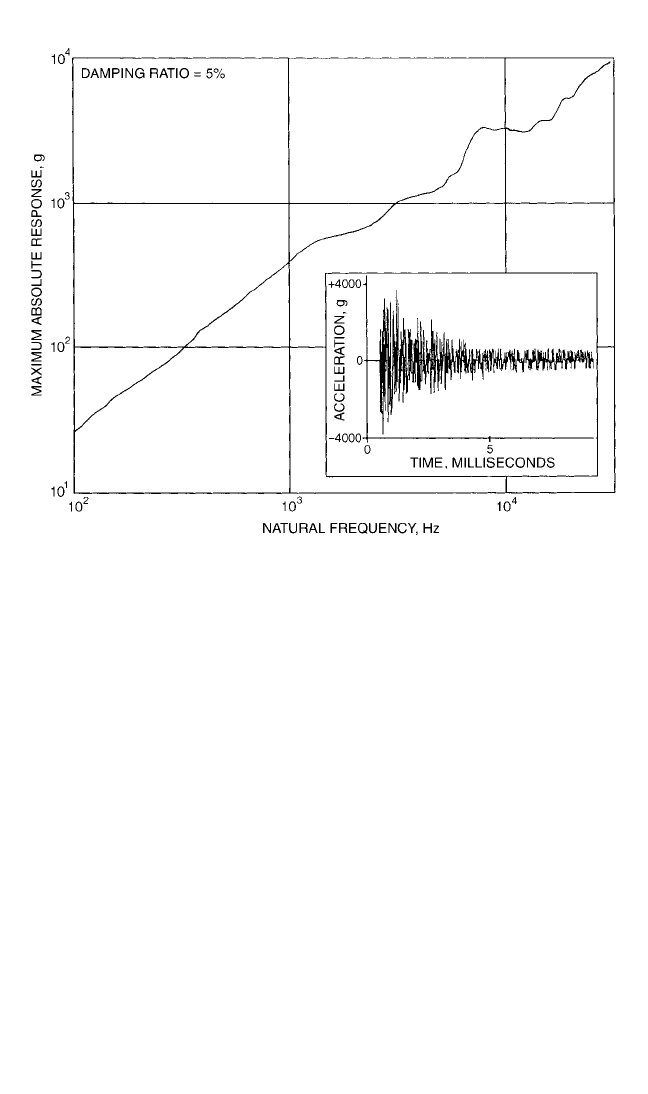
energy is usually concentrated at one or a few frequencies which correspond to dom-
inant structural mode(s).
A more detailed discussion of shock response spectrum (see Chap. 23 for defini-
tion) applications is given later in this chapter, but it is introduced here as a means of
describing pyroshock characteristics. Many far-field pyroshock environments have a
typical shock response spectrum shape as illustrated in Fig. 26.11, which shows an actual
far-field pyroshock acceleration transient along with its associated shock response
spectrum. The shock response spectrum initially increases with frequency at a slope of
9 to 12 dB/octave, followed by an approximately constant or slightly decreasing ampli-
tude. The frequency at which the slope changes is called the knee frequency, and it cor-
responds to a dominant frequency in the pyroshock environment.The knee frequency
is often between 1000 and 5000 Hz for far-field pyroshock, but it could be higher or
lower in some cases. Near-field pyroshock may also exhibit this typical pyroshock
shock response spectrum except with a higher knee frequency. However, since near-
field pyroshock usually has broad-band frequency content,its shock response spectrum
often exhibits a more complex shape that contains numerous excursions but on aver-
age follows a 6-dB/octave slope over the entire frequency range of interest. Figure
26.10 shows an example of this type of near-field shock response spectrum.
No fixed rules define at what distance from the pyrotechnic source the near-field
pyroshock ends and the far-field pyroshock begins. It is more appropriate to classify
near- and far-field pyroshock according to the various test techniques that are
appropriate to employ in each case.
PYROSHOCK TESTING 26.17
FIGURE 26.10 Shock response spectrum and acceleration time-history for a near-field
pyroshock. The shock response spectrum is calculated from the inset acceleration time-
history using a 5 percent damping ratio.
8434_Harris_26_b.qxd 09/20/2001 11:54 AM Page 26.17
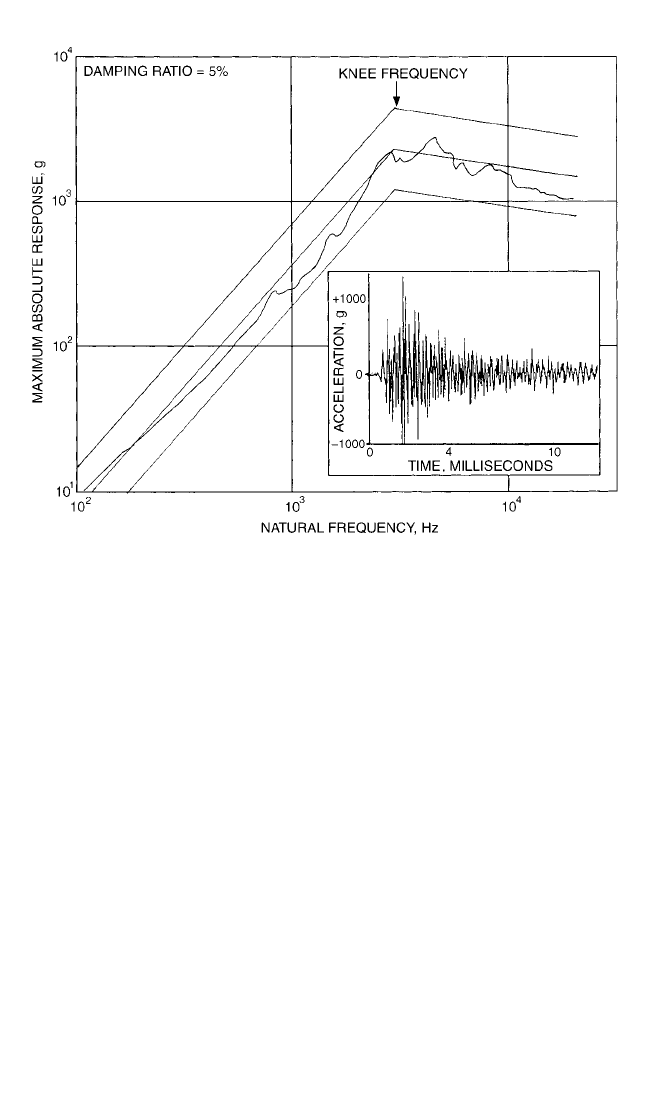
TEST TECHNIQUES FOR NEAR- AND FAR-FIELD PYROSHOCK
The pyroshock simulation techniques described in this chapter fall into two cate-
gories: (1) pyrotechnically excited simulations and (2) mechanically excited simu-
lations. A short-duration mechanical impact on a structure causes a response
similar to that produced by a pyrotechnic source. Although these mechanically ex-
cited simulations can be carried out with lower cost and better control than pyro-
technically excited simulations, they cannot produce the very high frequencies
found in near-field pyroshock. Mechanically excited simulations allow control of
dominant frequencies up to about 10,000 Hz (or higher for very small test items).
For environments requiring higher frequency content, a pyrotechnically excited
technique is usually more appropriate. The following general guidelines apply in
selecting a technique for simulating pyroshock:
Near-field pyroshock. For a test that requires frequency control up to and above
10,000 Hz, a pyrotechnically excited simulation technique is usually required.
Far-field pyroshock. For a test that requires frequency control no higher than
10,000 Hz, a mechanically excited simulation technique is usually acceptable.
These guidelines are not rigid rules, but they provide a reasonable starting point
when planning a pyroshock simulation test.
26.18 CHAPTER TWENTY-SIX, PART II
FIGURE 26.11 A typical shock response spectrum and acceleration time-history for a far-
field pyroshock.The shock response spectrum is calculated from the inset acceleration time-
history using a 5 percent damping ratio.The straight lines indicate tolerance bands (typically
±6 dB as shown) which might be applied for qualification test specification.
8434_Harris_26_b.qxd 09/20/2001 11:54 AM Page 26.18

QUANTIFYING PYROSHOCK FOR TEST SPECIFICATION
An intrinsic characteristic of pyroshock is its variability from one test to another.That
is, even though great care has been taken with the test technique, the measured
response in both the near and the far fields may vary a great deal from test to test.This
variability occurs in the situation where actual explosive devices are used and in the
laboratory where more controlled techniques are employed. As a result, various tech-
niques have been sought to quantify pyroshock for test specification. The purpose of
these techniques is to define the pyroshock in a manner that can be reproduced in the
laboratory and can provide a consistent evaluation for hardware that must survive
pyroshock in field environments. All techniques require that a measurement be made
of the actual pyroshock event at or near the location of the subsystem or component
that will be tested. The measurement may be acceleration, velocity, or displacement,
but acceleration is the most widely used measure. The measurement is then used with
one of the techniques below to obtain a test specification for pyroshock. The shock
response spectrum is considered to be conservative and a potential over-test of com-
ponents and subsystems. However, components and subsystems that survive labora-
tory tests specified using shock response spectra generally survive pyroshock field
environments, although they may be over-designed. Because aerospace systems
require lightweight components and subsystems, other techniques such as temporal
moments and shock intensity spectrum have been developed so that laboratory tests
can more closely simulate actual pyroshock events and allow tighter design margins.
Shock Response Spectra. By far the most widely used technique for quantifying
pyroshock is the shock response spectrum.This technique provides a measure of the
effect of the pyroshock on a simple mechanical model with a single degree-of-
freedom. Generally, a measured acceleration time-history is applied to the model,
and the maximum acceleration response is calculated. The damping of the model is
held constant (at a value such as 5 percent) for these calculations. An ensemble of
maximum absolute-value acceleration responses is calculated for various natural
frequencies of the model and the result is a maxi-max shock response spectra. A
curve representing these responses as a function of damped natural frequency is
called a shock response spectrum (see Chap. 23), and is normally plotted with log-
log scales. Velocity and displacement shock response spectra may be computed (see
Chap. 26, Part I), but are not commonly used for pyroshock specification.The shock
response spectrum for pyroshock has a characteristically steep slope at low frequen-
cies of 12 dB/octave that is a direct result of the minimal velocity change occurring
in a pyroshock. Occasionally, a pyrotechnic device, such as an explosive bolt cutter,
is combined with another mechanism, such as a deployment arm, to position com-
ponents for a particular event sequence. In this case, a distinct velocity change is
combined with the pyroshock event, and the low-frequency slope of the shock
response spectrum will reflect this velocity change. For a typical far-field pyroshock,
the low-frequency slope changes at the knee frequency, and the shock response spec-
trum approaches a constant value at high frequencies that is the peak acceleration in
the time-domain as shown in Fig. 26.11.A typical near-field pyroshock may have this
shape or may have the shape shown in Fig. 26.10. Conventionally, tolerance bands of
±6 dB are drawn about a straight-line approximation of the shock response spec-
trum for laboratory testing.An example of a typical maxi-max shock response spec-
trum is shown in Fig. 26.11 with the conventional ±6 dB tolerance bands.
Band-Limited Temporal Moments. The method of temporal moments may be
used for modeling shocks whose time durations are too short for nonstationary
PYROSHOCK TESTING 26.19
8434_Harris_26_b.qxd 09/20/2001 11:54 AM Page 26.19

models and that contain a large random contribution.
4
The method uses the magni-
tude of the Fourier spectrum in the form of an energy spectrum (Fourier spectrum
magnitude squared) that is smoothed or formed from an ensemble average to gen-
erate statistically significant values. Temporal moments of the time-histories are
used to represent how the energy is distributed in time. The moments are analogous
to the moments of the probability density functions and provide a convenient
method to describe the envelopes of complicated time-histories such as pyroshock.
The ith temporal moment m
i
(a) of a time-history f(t), about a time location a, is
defined as
m
i
(a) =
+∞
−∞
(t − a)
i
[f(t)]
2
dt (26.2)
The time-history energy E is given by
E =
+∞
−∞
|F(ω)|
2
dω (26.3)
where F(ω) is the Fourier transform of f(t). The first five moments are used in the
temporal moments technique. The zeroth-order moment m
0
is the integral of the
magnitude squared of the time-history and is called the time-history energy.The first
moment normalized by the energy is called the central time τ.A central moment is a
moment computed about the central time, i.e., a =τ. The second central moment is
normalized by the energy and is defined as the mean-square duration of the time-
history. The third central moment normalized by the energy is defined as the skew-
ness and describes the shape of the time-history. The fourth central moment
normalized by the energy is called kurtosis. The moments are calculated for a shock
time-history passed through a contiguous set of bandpass filters. A product model is
formed using a deterministic window w(t) (see Chap. 25) and a realization of a
dimensionless stationary random process with unity variance x(t) as w(t)⋅x(t +τ). A
product model is then used to generate a simulation that has the same energy and
moments in the mean as the original shock. Band-limited moments characterize the
shock and not the response to the shock as the shock spectrum and do not rely on a
structural model.
Other Techniques. Other techniques to quantify pyroshock include the shock
intensity spectrum based on the Fourier energy spectrum,
5
the method of least favor-
able response,
6,7
and nonstationary models.
8,9
These techniques are not commonly
used but may provide additional insight for quantifying pyroshocks. The Fourier
spectrum is an attractive alternative to shock response spectrum because it is easy to
compute and readily available in many software packages as a fast Fourier trans-
form (FFT). Since the Fourier spectrum is complex, both magnitude and phase
information is available. The magnitude generally has intuitive meaning, but the
phase is difficult to interpret and may be contaminated with noise at the high fre-
quencies present in pyroshock. The method of least favorable response provides a
method of selecting the phase to maximize the response of the system under test.
This method results in a conservative test provided that an appropriate measure-
ment point is chosen on the structure. Stationary models for random vibration have
been used for many years. Nonstationary models consist of a stationary process mul-
tiplied by a deterministic time-varying modulating function, which is a product
model.
9
A nonstationary model is appropriate for pyroshock and approaches a sta-
tionary model as the time-record length is increased.
1
2π
26.20 CHAPTER TWENTY-SIX, PART II
8434_Harris_26_b.qxd 09/20/2001 11:54 AM Page 26.20

MEASUREMENT TECHNIQUES
Measurements of pyroshocks are generally made with accelerometers, strain gages,
or laser Doppler vibrometers (LDV). The accelerometers are used to measure
acceleration, and the strain gages and LDV are used to measure velocity. The strain
gages may also be used to sense force, stress, or strain. General shock measurement
instrumentation is applicable for pyroshock measurements (see Chap. 12); how-
ever, care must be taken to protect accelerometers from the high frequencies con-
tained in pyroshocks that may cause the accelerometers to resonate and, in some
cases, to fail. If accelerometers are excited into resonance, large-magnitude output
results and may exceed the maximum amplitude of the data acquisition system that
was chosen for the test. The result is that the data magnitude is clipped. If clipped,
the data are rendered useless and the results from the test will be greatly dimin-
ished. Several mechanically isolated accelerometers are available commercially
and should be used if there is a possibility of exciting the accelerometers into reso-
nance. There is only one mechanically isolated accelerometer that can provide the
wide-frequency bandwidth (dc to 10 kHz) required for pyroshock.
10,11
Other
mechanical isolators generally provide a frequency bandwidth of about dc to 1 kHz.
Any mechanical isolator that is used in a pyroshock environment must be well
characterized over a range of frequencies and a range of acceleration values using
a shock test technique, for example, Hopkinson bar testing. Strain gages are useful
measurements of the pyroshock environment but are not easily translated into a
test specification. Strain gages have the advantage of high-frequency response (in
excess of dc to 40 kHz) provided that their size is appropriately chosen. Addition-
ally, strain gages do not have the resonance problems that accelerometers have.The
LDV provides velocity measurements that are not contaminated by cross-axis
response because the LDV only responds to motion in the direction of the laser
beam. The LDV is a noncontacting measurement and is easy to set up; consistent
measurements of pyroshock events have been obtained with a LDV.
12,13
The LDV
has the disadvantage of being very expensive per channel in comparison to the
other measurement techniques, difficult to calibrate, and must have line of sight to
the measurement location.
Pyroshock Test Specifications. An acceleration or velocity time-history is not
adequate for specifying a pyroshock test. The time-history data must be analyzed
using one of the techniques discussed above to quantify the pyroshock for a test
specification. Ideally, the time-history data that are used to develop the qualification
test specification should be measured during a full-scale system test in which the
actual pyrotechnic device or devices were initiated. The full-scale test should be
accomplished with hardware that is structurally similar to the real hardware if the
real hardware is not available. A control point measurement is specified close to
each component or subassembly of interest, preferably at the attachment point to
measure the input pyroshock. Since full-scale testing is expensive, data from a simi-
lar application may be used to develop component or subassembly qualification test
specifications. This practice may result in over-tested or over-designed components
or subassemblies if a large margin is added to the test specification to account for the
uncertainty in the data. If this practice is used, the test specification should be
revised when better system data become available.
Once the time-history data have been acquired, the data should be scrutinized to
ensure their quality.
3
The data should be free of zero-shifts and offsets. Acceleration
and velocity time-histories should be integrated and the results examined.The time-
PYROSHOCK TESTING 26.21
8434_Harris_26_b.qxd 09/20/2001 11:54 AM Page 26.21

history data should be low-pass filtered at a designated cutoff frequency; a cutoff fre-
quency of 20 kHz is typical. The data must then be analyzed using the same tech-
nique as was used for analysis of the time-history data from which the test
specification was derived. Test margin and tolerance bands are applied to the data
analysis. For instance, if the shock response spectrum is being used, a straight-line
approximation of the shock response spectrum is used as the baseline for the test
specification process. A margin of 3 dB is typically added to the baseline shock
response spectrum, and a customary ±6-dB tolerance is used with the baseline shock
response spectrum. A typical test specification may allow the shock response spec-
trum from the actual test to fall outside the tolerance band at a specified number of
frequency points. Pyroshock tests are highly variable, and the engineer must specify
how much variability from test to test will be accepted; in some cases, a tighter, ±3-
dB tolerance may be required.Additionally, the specification should require that the
peak acceleration (or velocity) value and pulse durations are in agreement with the
intended values for the specified input pulse. Similar approaches are used for other
techniques for quantifying pyroshock.
In some cases, two or more pyroshock events, such as stage separation and an
explosive actuator, may be combined into a single test specification. If the events
are significantly different, the resulting test specification may be difficult or impos-
sible to meet. A better practice is to make separate test specifications for each
pyroshock event and to combine the specifications only in the case where a realiz-
able test results.
PYROSHOCK SIMULATION TECHNIQUES
PYROTECHNICALLY EXCITED NEAR-FIELD SIMULATION
Ordnance Devices. Linear, flexible detonating charges may be used to generate
pyroshocks for test purposes.An example of a test configuration using a flexible lin-
ear charge is shown in Fig. 26.12.A steel plate is suspended by bungee cords, and the
test item is mounted on the plate in the same manner as it is in actual usage. Flexible
linear charge is attached to the edges of the plate. The charge configuration may be
varied according to experience and the desired effect.
14
For example, the charge may
be attached to the backside of the plate directly opposite to the test item. A mass-
mockup of the actual test item is used for the trial and error required to finalize the
test configuration. In some cases, the charges may be attached to a portion of the
structure where the test items are installed. Their storage, handling, and detonating
constitute a hazard to laboratory personnel and facilities. However, such a fixture
would normally be rather expensive because the structure would be damaged or
destroyed during each shock test. The shock produced in this manner may vary
greatly from test to test because actual explosives are used. However, this test con-
figuration has the advantage of reproducing the pyroshock with realistic high accel-
erations and high frequencies. To ensure repeatability, the grooves generated by the
charge into the surfaces of the shock plates should be machined down to eliminate
the porosity which tends to absorb and modify the explosive impacts. Other disad-
vantages are that a qualified explosives facility (with its associated safety proce-
dures) is required. In comparison to mechanical simulation techniques, considerable
time is needed to conduct the numerous trial tests required to experimentally deter-
mine the various test parameters.
26.22 CHAPTER TWENTY-SIX, PART II
8434_Harris_26_b.qxd 09/20/2001 11:54 AM Page 26.22
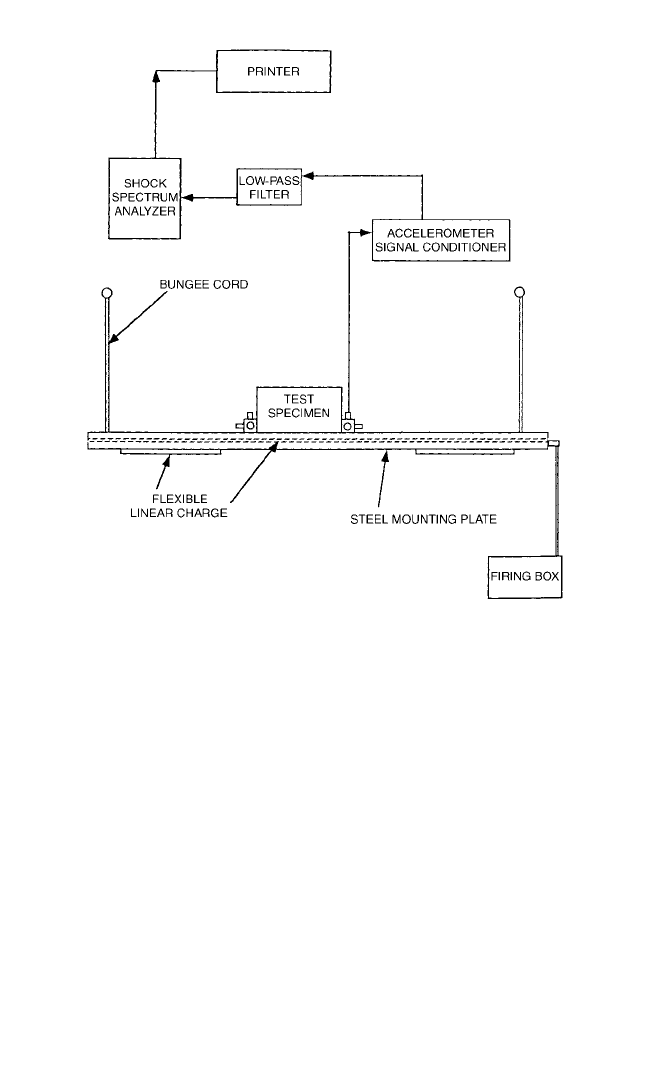
Scaled Tests. If the quantity of propellant or explosive is sufficiently large and
the influence of the pyrotechnic device is localized, a scaled portion of the structure
may be used in simulating the effects of the pyroshock as shown in Fig. 26.13 where
a missile section or rocket payload section is shown. This type of test assumes that
the influence of the pyrotechnic event is insignificant to other parts of the structure
and isolated to the section under test. Actual pyrotechnic device firings on space-
craft equipment and scientific instruments are conducted in the scaled test. Such a
test is usually an intermediate step in the design of the structure. Components in the
subassembly may have been qualified with a ordnance device, and the scaled test
adds another dimension of complexity to the qualification of the subassembly and
its individual components.
Full-Scale Tests. In some cases, if the structure is sufficiently complex, a full-
scale test may be warranted. Full-scale tests, which include multiple firings of certain
critical pyrotechnic devices, are conducted to verify the structural integrity and
design functions as well as to qualify items of hardware that have not been previ-
ously qualified. Full-scale tests are conducted by actuation of the flight pyrotechnic
devices, which provide full-scale shock qualification. A full-scale test is usually the
last test in a sequence of increasingly complex tests; the sequence is from ordnance
to scaled tests to full-scale tests. The advantage of a full-scale test is that it is the real
PYROSHOCK TESTING 26.23
FIGURE 26.12 Ordnance-generated pyroshock simulator. (Courtesy of
National Technical Systems.)
8434_Harris_26_b.qxd 09/20/2001 11:54 AM Page 26.23

pyroshock event in its most complex form. The main objectives of the full-scale
pyroshock test firings are: (1) to define shock response in the vicinity of potentially
sensitive equipment so that component test specifications may be derived or verified
and (2) to conduct full-scale qualification and thus verify the design values for
shock.The disadvantage of a full-scale test is that considerable time and expense are
required to obtain all the required hardware.The hardware must then be assembled,
instrumented, and removed for post-test evaluation. Generally, special facilities are
required for the use of explosives.
MECHANICALLY EXCITED FAR-FIELD SIMULATION
Standard Shock-Testing Machines. Shock machines such as the drop tables
described in Part I of this chapter usually are not suitable for pyroshock simula-
tion. The single-sided pulses produced by these machines bear little or no resem-
blance to a pyroshock acceleration transient; such pulses produce significantly
greater velocity change than a pyroshock environment. A severe over-test at low
frequencies can be expected if a drop table is used to simulate pyroshock environ-
ments. This can result in failures of structural members that would not have been
significantly stressed by the actual pyroshock. However, in certain cases, drop
tables may produce acceptable pyroshock qualification testing. For example, if a
test item has significant design margin at low frequencies, then a drop table may be
acceptable. Also, if the lowest natural frequency of the test item is higher than the
over-tested low-frequency range, then the low-frequency over-test may be irrele-
vant since the affect on the test item is dominated by the peak g’s of the accelera-
26.24 CHAPTER TWENTY-SIX, PART II
FIGURE 26.13 Scaled tests using representative structure. The test vehicle midbody
section is a portion of the full-scale structure where the explosive event is located.Two
input control stations A and B are used to determine that the test was properly con-
ducted. Response measurements are made at test specimens A and B. (Courtesy of
Wyle Laboratories.)
8434_Harris_26_b.qxd 09/20/2001 11:54 AM Page 26.24
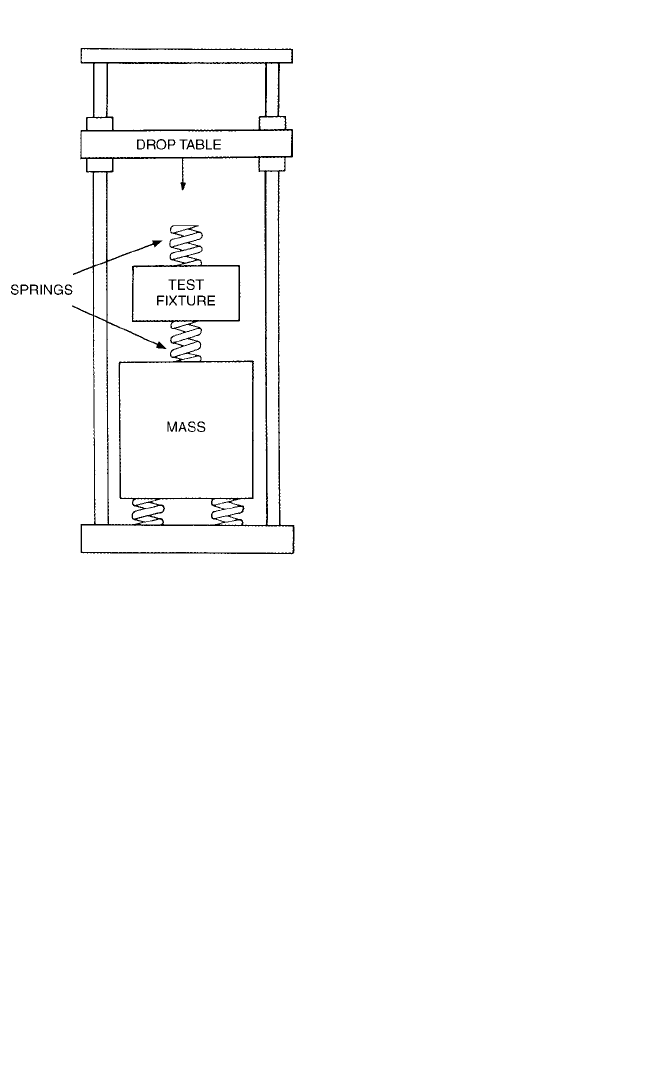
tion time-history. In these cases there is
strong motivation to use drop tables
due to their common availability and
low test cost. If a drop table is selected
as a means of conducting a pyroshock
qualification test, the test item must be
subjected to a shock in both positive
and negative directions for each axis
tested, since the drop table produces
only a single-sided pulse.
Another application of a drop table
for pyroshock testing is the bounded
impact method
15
as illustrated in Fig.
26.14, which shows the test item fixture
bounded by two springs (typically felt or
elastomeric pads). When the drop table
strikes the upper spring, the fixture
oscillates at the natural frequency of the
spring-mass system. This oscillation
ceases when the drop table rebounds
from the spring, resulting in an accelera-
tion transient that appears as a decayed
sinusoid with about two or three cycles.
The velocity change is much less than
for a haversine pulse, which results in a
shock spectrum with the desired slope of
9 to 12 dB/octave. Knee frequencies up
to about 2000 Hz are attainable with this
method.
Electrodynamic Shakers. Pyroshock environments can be simulated with an
acceleration transient produced on an electrodynamic shaker (see Chap. 25). In this
method the acceleration transient is synthesized so that its shock response spectrum
closely matches the test requirement. With this method a relatively complex shock
response spectrum shape can be matched within close tolerances up to about 3000
Hz. The equipment limits (maximum acceleration) restrict this method to the simu-
lation of lower-energy pyroshock environments. Even if the desired shock response
spectrum is precisely met, an over-test is likely due to the high mechanical imped-
ance of the shaker relative to the structure to which the test item is attached in a real
application.
Resonant Fixtures. This section describes a variety of resonant fixture tech-
niques used to simulate pyroshock environments. All of these methods utilize a fix-
ture (or structure) which is excited into resonance by a mechanical impact from a
projectile, a hammer, or some other device. A test item attached to the fixture is thus
subjected to the resonant response, which simulates the desired pyroshock. There is
no single preferred method since each has its own relative merits. Some of the meth-
ods require extensive trial-and-error iterations in order to obtain the desired test
requirement. However, once the procedures are determined, the results are very
repeatable. Other methods eliminate the need for significant trial and error but are
usually limited to pyroshock environments which exhibit the typical far-field char-
acter as explained in Fig. 26.13.
PYROSHOCK TESTING 26.25
FIGURE 26.14 Bounded impact test configu-
ration on a “standard” drop-table.
8434_Harris_26_b.qxd 09/20/2001 11:54 AM Page 26.25
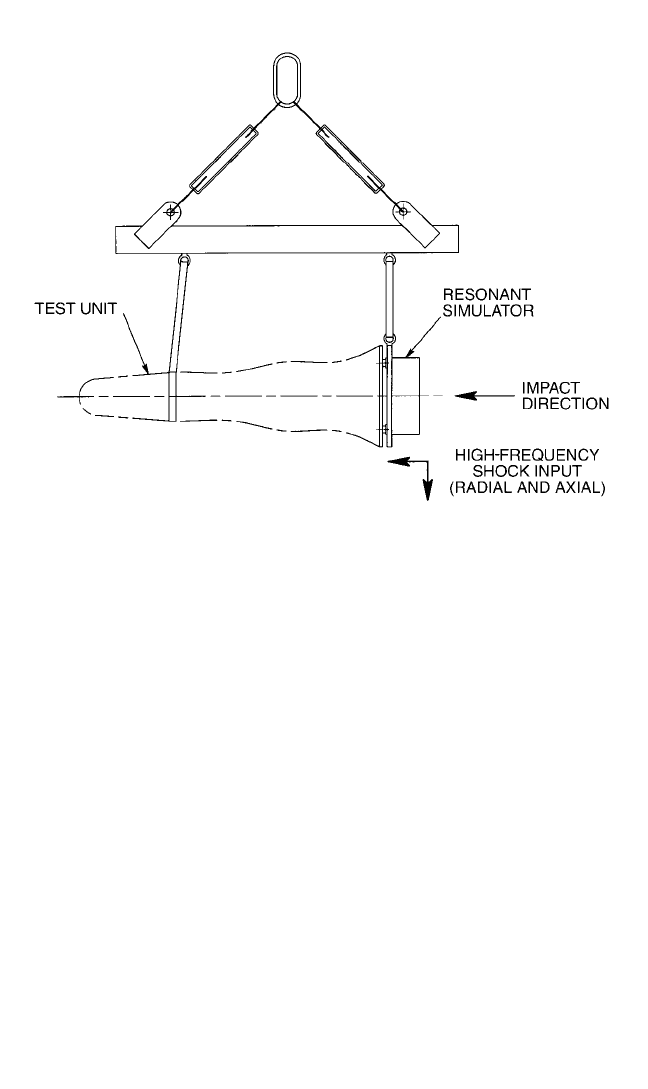
Full-Scale Tests. Some mechanically excited simulation techniques involve
the use of an actual or closely simulated structure
16,17
(e.g., an entire missile pay-
load section). The pyrotechnic devices (e.g., explosive bolt cutters) normally
located on this structure would then be replaced with hardware that allow a con-
trolled impact at this same location. Since a closely simulated structure is used, it is
anticipated that the impact will cause the modes of vibration of the structure to be
excited in a manner similar to the actual pyrotechnic source. In principle, test
amplitudes can be adjusted by changing the impact speed or mass. This method is
relatively expensive due to the cost of the test structure and because significant
trial and error is required to obtain the desired test specification. Since this method
applies to a specific application, it is not suited as a general-purpose pyroshock
simulation technique.
In a variation of the above method
18
the pyrotechnic source and a portion of the
adjacent structure are replaced by a “resonant plate” designed so that its lowest-
resonance frequency corresponds to the dominant frequency produced by the
pyrotechnic device and its associated structure. The resonant plate is then attached
to the test structure in a manner which simulates the mechanical linkage of the
pyrotechnic source, as shown in Fig. 26.15. When this plate is subjected to a mechan-
ical impact, its response will provide the desired excitation of the test structure. A
resonant fixture has successfully simulated component shock response spectra for
frequencies up to 4000 Hz on a full-scale structure weighing 400 lb.
19
General-Purpose Resonant Fixtures. Instead of developing application-
specific pyroshock methods as described above, it may be desirable to implement a
more general-purpose test method which can be used for a variety of test items
26.26 CHAPTER TWENTY-SIX, PART II
FIGURE 26.15 Full-scale pyroshock simulation with resonant fixture. Measurements
at component locations confirm simulation success.
8434_Harris_26_b.qxd 09/20/2001 11:54 AM Page 26.26
